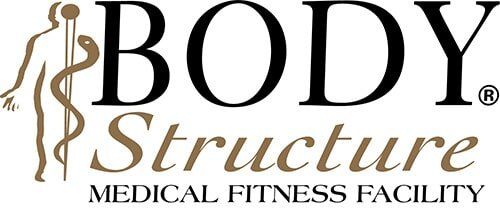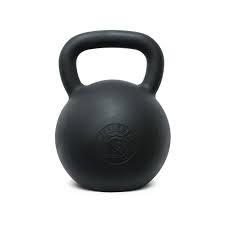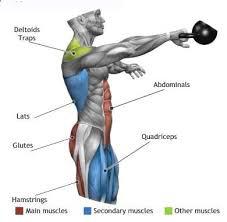THE KETTLEBELL SWING
If you sit, hunched over your desk for hours on end, more than likely, your back side from shoulders to ankles (posterior chain) is feeling a bit neglected. How are you ever going to get that strong posterior chain with a solid core and powerful hips? There’s more than one answer to that question, but we’ll focus on the kettlebell swing.
So what is a kettlebell swing? First, let’s check out the equipment. A kettlebell is simply a cannon ball with a handle. To swing the kettlebell, take that handled cannon ball, bend at the hips, hike the cannon ball between your legs, quickly stand up, and swing the cannon ball forward. It’s not quite as easy as it sounds.
Before attempting a kettlebell swing, you must understand that the movement comes from bending at the hips (hip hinge) while keeping the spine straight (neutral). A hip hinge involves maximal hip bend and minimal knee bend. The kettlebell swing should not be performed until you are able to demonstrate a good hip hinge movement. When you bend over to put your hands on the handle of the kettlebell, your spine should be straight, not shaped like a question mark. Keep in mind, the hip hinge (and the kettlebell swing) involves bending at the hips more than the knees. There are a variety of ways to learn to hinge correctly while keeping a neutral spine. I suggest finding a fitness professional to help with efficiency and to stay injury free.
Once the hip hinge movement is correct, comfortable, and natural, you’re ready to attempt a kettlebell swing. The steps for the swing are:
- Set the kettlebell on the floor between your feet and about a foot length in front.
- Grab the handle with a neutral spine. Without swinging the bell, load the exercise by creating tension through your back, hips, and hamstrings.
- Initiated the swing by hiking the kettlebell between your legs like it were a football.
- Quickly extend your hips and finish in an upright standing position. Clench your cheeks (not the ones on your face) hard enough to crack walnuts. The kettlebell swing is supposed to be a quick and explosive movement.
- The momentum of standing up quickly and extending your hips will cause the kettlebell to swing up. Do not let the bell swing higher than your chest because it will lead to unnecessary (and potentially dangerous) hyperextension of the spine at the low back.
- Try to keep your forearms attached to your inner thighs. When they swing off your thighs, quickly get them back. The swing’s momentum is a result of your hip hinge and extension and not your arms/shoulders lifting.
- As you’re reattaching your forearms to your inner thighs, you’re also bending over at the hips (remember neutral spine) and returning to the post hike position.
- Allow the unassisted momentum to swing the kettlebell back to the starting position a foot length in front and set the kettlebell down.
You have now just performed one kettlebell swing repetition. The video link below first shows just one rep and then several reps strung together.
There are many advantages to adding the kettlebell swing to your exercise program. The swing is a full body exercise, so muscles from your calves to your hands must work together to perform the exercise correctly. Many muscles working together makes the kettlebell swing ideal for metabolic conditioning, but since it is such a quick explosive movement, the swing is also good for strengthening.
Be sure to practice. A proper kettlebell swing can’t be learned quickly. Be patient, and keep practicing and improving.

























